|
|
 |
Fiche d'espèce de Copépode |
|
|
Calanoida ( Ordre ) |
|
|
|
Calanoidea ( Superfamille ) |
|
|
|
Megacalanidae ( Famille ) |
|
|
|
Bradycalanus ( Genre ) |
|
|
| |
Bradycalanus enormis Björnberg, 1968 (F,M) | |
| | | | | | | Syn.: | Bradycalanus pseudotypicus enormis Björnberg, 1968 (p.85, figs.F,M) | | | | Ref.: | | |
Bradford-Grieve, Blanco-Bercial & Boxshall, 2017 (p. 41, figs. F,M) as Bradycalanus enormis | 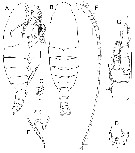 Issued from : J.M. Bradford-Grieve, L. Blanco-Bercial & G.A. Boxshall in Zootaxa, 2017, 4229 (1). [p.54, Fig.24]. Female (from 13.32°N, 92.033°W): A-B, habitus (dorsal and lateral, respectively); C, detail of genital double-somite showing seminal receptacle (sr); D, caudal ramus (dorsal); E, rostral filaments 'anterior view); F, A1; G, P1. Scale bars: 1.0 mm (A, B, D, F, G); 0.1 mm on remaining figures. Nota: - Head without projection. - Rostrum bent ventrally. - Pediger 5, in lateral view, extended into triangular lappets terminating in short point or triangular spine.
- Genital double-somite in dorsal view widest at anterior 1/3.
- A1 extending about 7 segments beyond caudal rami.
- P1 exopodal segment 3 about 2.7 times as long as maximum width; distal border of endopodal segment 1 extends as far as distal border of exopodal segment 1; rxopod outer spines: on segment 1 extends less than half way along segment 2; on segment 2 extends half distance to 1st spine on segment 3; segment 3 propximal spine extends almost to base of distal spine.
|
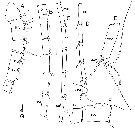 Issued from : J.M. Bradford-Grieve, L. Blanco-Bercial & G.A. Boxshall in Zootaxa, 2017, 4229 (1). [p.55, Fig.25]. Female (from 13.155°S, 0.316°E): A, ancestral segments I-IX; B, ancestral segments X-XVI; C, ancestral segments XVII-XXI; D, ancestral segments XXII-XXVIII; E, detail of terminal segments; F, detail of dorsal surface of ancestral segments I-V showing positions of hair sensilla (hs); G, detail of hair sensillum from ancestral segment I. Scale bars: 1.0 mm (A-D, F); 0.1 mm on remaining figures.
|
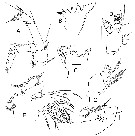 Issued from : J.M. Bradford-Grieve, L. Blanco-Bercial & G.A. Boxshall in Zootaxa, 2017, 4229 (1). [p.56, Fig.26]. Female (from 05.350°N, 133.583°W): A, A2; B, distal part of Md gnathobase; C, detail of dorsal border of Md gnathobase; D, Md palp; E, Mx1; F, basal endite 2 and endopod of Mx1; G, coxal endite and basal endite 1 of Mx1. Scale bars: 1.0 mm (A, B, D, E); 0.1 mm onremaining figures. Nota: - A2 exopodal segments I-III each with short but well-developed seta, segment IV with well-developed sera extending as far as distal border of segment VIII. - Mx1 coxal endite with 5 setae, one of them short; endopodal segment 2 with 1 long and 1 vestigial seta; segment 3 with posterior surface seta short.
|
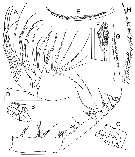 Issued from : J.M. Bradford-Grieve, L. Blanco-Bercial & G.A. Boxshall in Zootaxa, 2017, 4229 (1). [p.57, Fig.27]. Female (from 05.350°N, 133.583°W): A, Mx2; B, detailed inner view of endopod of Mx2; C, detailed outer view of endopod of Mx2; D, detail of vestigial seta of coxal epipodite; E, seta of coxal endite 2 of Mx2; F, detail of seta of coxal endite 2 of Mx2; G, inner seta of praecoxal endite 2 of Mx2; H, seta of praecoxal endite 1 of Mx2; I, Mxp. Scale bars: 1.0 mm (A, I); 0.1 mm on remaining figures.
|
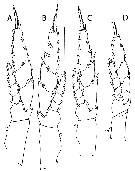 Issued from : J.M. Bradford-Grieve, L. Blanco-Bercial & G.A. Boxshall in Zootaxa, 2017, 4229 (1). [p.58, Fig.28 A-D]. Female (from 05.350°N, 133.583°W): A, P2; B, P3; C, P4; D, P5. Scale bar: 1.0 mm (A, B, C, D).
|
 Issued from : J.M. Bradford-Grieve, L. Blanco-Bercial & G.A. Boxshall in Zootaxa, 2017, 4229 (1). [p.58, Fig.28 E, F]. As Bradyidius pseudotypicus enormis Björnberg, 1968. Male (from USNM122577): E, P5 (anterior view); F, distal inner corner of left P5 exopod segment 2. Scale bars: 1.0 mm (E); 0.1 mm (F). Nota: - Forehead rounded in dorsal view. - Pediger 5, in lateral view, slightly pointed. - A2 exopod segments I-IV each with less well-developed setae than in female. - Mx1 endopodal segment 1 with 2 setae, segment 2 with 1 seta. - P5 left exopodal segment 2 specialised seta tapering, with small proximal tapering projection on outer margin; specialised seta in form of long setulose lash extending short of distal border of endopodal segment 2; inner border of left exopodal segment 3 setulose with inner articulated spine inserted just proximal to 2nd outer (terminal) spine; inner border of right exopodal segment 3 naked and without notches, inner articulated spine inserted distal of 1st outer border spine.
|
 issued from : T.S.K. Björnberg in Antarctic Res. Ser., 1968, 11. [p.85, Fig.64, A-C]. As Bradycalanus pseudotypicus enormis. Female (from SW of Valdivia, Chile): 64 A, habitus (dorsal); 64 B, idem (lateral right side); 64 C, pointed lateral margin of the last thoracic segment. Nota: The proportional lengths (%) of the body segments from the head to the last abdominal segment 41.9 : 8.6 : 8.6 : 9.2 : 5.5 :3.0 :9.2 : 4.9 : 4.3 :2.4 : 2.1 = 100 Remarks: The subspecies enormis was established because of the very large size, the slight difference in the setatuion of Mx1 and the different proportions between the sizes of the cephalothorax and the abdomen.
|
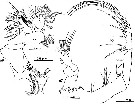 issued from : T.S.K. Björnberg in Antarctic Res. Ser., 1968, 11. [p.86, Fig.65-68]. As Bradycalanus pseudotypicus enormis. Female: 65, Mxp; 66, Mx1; 67, Md; 68, lamina labialis, labial lobes, part of serrula, view from pharynx.
|
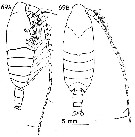 issued from : T.S.K. Björnberg in Antarctic Res. Ser., 1968, 11. [p.85, Fig.69, A-B]. As Bradycalanus pseudotypicus enormis. Male (from SW Valdivia, Chile): 69 A, habitus (lateral right side); 64 B, idem (dorsal). Nota: Right A1 without grasping organ, segments 10 to 17 inclusive, being more oval, distinctly different from the other segments, which are more polygonal; left A1 lacking. Posterior thoracic margin distinctly pointed (visible in dorsal view). 5 thoracic segments and 5 abdominal segments which have the proportional lengths from the head to the last abdominal segment 500 : 77 : 81 : 73 : 28 : 56 : 40 : 73 : 36 : 24 : 16 = 1000
|
 issued from : T.S.K. Björnberg in Antarctic Res. Ser., 1968, 11. [p.85, Fig.70-77]. As Bradycalanus pseudotypicus enormis. Male: 70, A2; 71A, Md (masticatory edge); 71B, Md (mandibular palp); 72, Mx1; 73, Mx2; 74, Mxp; 75, P1; 76, P2; 77, P5.
|
 Issued from : J.M. Bradford-Grieve, L. Blanco-Bercial & G.A. Boxshall in Zootaxa, 2017, 4229 (1). [p.66, Table 8]. Morphological characters after identification key of Bradycalanus females and males. Compare to other species of genus. Main characters identification after species key : 1 - Head rounded; posterior pediger 5 corners triangular in lateral view; Mx1 coxal endite with 5 setae. 2 - Female A1 long extending about 6-7 segments beyond caudal rami; P1 exopod segment 1 and 2 with outer border spines short extending well short of base of following spine. 3 - Female total body length > 14 mm; male right P5 exopod segment 3 inner border spine inserted distal to level of outer border spine insertion, inner border without notch.
|
 issued from : T.S.K. Björnberg in Antarctic Res. Ser., 1968, 11. [p.86]. As Bradycalanus pseudotypicus enormis. Male: Proportional lengths of A1 segments. Nota: Left A1 lost; the right A1 shows no change into a grasping organ. Segments 10 to 17 being more oval and distinctly different from the other segments, which are more polygonal.
| | | | | NZ: | 4 | | |
|
Carte de distribution de Bradycalanus enormis par zones géographiques
|
| | | | | | | Loc: | | | Southeastern Pacific (Antarct., S Chile), SE Atlantic (off Angola).
Type locality : 40.766° S, 76.800° W. | | | | N: | 2 | | | | Lg.: | | | (406) F: 14,1-17,10; M: 13,00; (1316) F: 15,3-17,1; M: 13,0; {F: 14,1-17,10; M: 13,00} | | | | Rem.: | Abyssopelagic: 2000 m to <5000 m.
For Bradford-Grieve & al. (2017, p.59) females are distinguished morphologically from their closest relative Br. typicus only by their large size (> 15 mm), but we cannot be certain of the identity between 13-15 mm total length. B. enormis and Br. typicus have the same mouthpart setation. Males are possibly distinguished by the more distal insertion of the inner spine on the right P5 exopode 3 relative to the outer spine and the lack of a notch in the inner border (Br. typicus has inner spine inserted opposite the outer spine and the inner border notched). Females of Br. enormis can be distinguished from Br. gigas by its triangular to pointed posterior corners of pediger 5 (rounded in Br. gigas). and by its long A1 extending about 7 segments beyond caudal rami (3 segments in Br. gigas) andP1 outer border spines of exopodal segments 1 and 2 which are short and not extending as far as the base of following spine (long in Br. gigas, extending to the base of the following spine)/ | | | Dernière mise à jour : 19/06/2023 | |
|
|
 Toute utilisation de ce site pour une publication sera mentionnée avec la référence suivante : Toute utilisation de ce site pour une publication sera mentionnée avec la référence suivante :
Razouls C., Desreumaux N., Kouwenberg J. et de Bovée F., 2005-2025. - Biodiversité des Copépodes planctoniques marins (morphologie, répartition géographique et données biologiques). Sorbonne Université, CNRS. Disponible sur http://copepodes.obs-banyuls.fr [Accédé le 04 décembre 2025] © copyright 2005-2025 Sorbonne Université, CNRS
|
|
 |
 |













